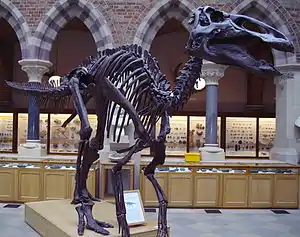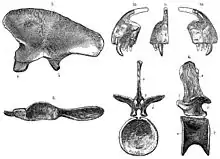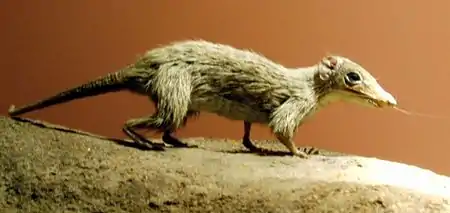Portal:Mesozoic
IntroductionThe Mesozoic Portal.jpg.webp) The Mesozoic Era is the second-to-last era of Earth's geological history, lasting from about 252 to 66 million years ago, comprising the Triassic, Jurassic and Cretaceous Periods. It is characterized by the dominance of archosaurian reptiles, such as the dinosaurs; an abundance of gymnosperms, (such as ginkgoales, bennettitales) and ferns; a hot greenhouse climate; and the tectonic break-up of Pangaea. The Mesozoic is the middle of the three eras since complex life evolved: the Paleozoic, the Mesozoic, and the Cenozoic. The era began in the wake of the Permian–Triassic extinction event, the largest well-documented mass extinction in Earth's history, and ended with the Cretaceous–Paleogene extinction event, another mass extinction whose victims included the non-avian dinosaurs, pterosaurs, mosasaurs, and plesiosaurs. The Mesozoic was a time of significant tectonic, climatic, and evolutionary activity. The era witnessed the gradual rifting of the supercontinent Pangaea into separate landmasses that would move into their current positions during the next era. The climate of the Mesozoic was varied, alternating between warming and cooling periods. Overall, however, the Earth was hotter than it is today. Dinosaurs first appeared in the Mid-Triassic, and became the dominant terrestrial vertebrates in the Late Triassic or Early Jurassic, occupying this position for about 150 or 135 million years until their demise at the end of the Cretaceous. Archaic birds appeared in the Jurassic, having evolved from a branch of theropod dinosaurs, then true toothless birds appeared in the Cretaceous. The first mammals also appeared during the Mesozoic, but would remain small—less than 15 kg (33 lb)—until the Cenozoic. The flowering plants appeared in the early Cretaceous Period and would rapidly diversify throughout the end of the era, replacing conifers and other gymnosperms as the dominant group of plants. (Full article...) Selected article on the Mesozoic world and its legacies Skeletal mount of Edmontosaurus Edmontosaurus has a lengthy and complicated taxonomic history dating to the late 19th century. The type species, E. regalis, was named by Lawrence Lambe in 1917, although several other species that are now classified in Edmontosaurus were named earlier. The best known of these is E. annectens, originally named by Othniel Charles Marsh in 1892. Edmontosaurus was widely distributed across western North America. The distribution of Edmontosaurus fossils suggests that it preferred coasts and coastal plains. It was an herbivore that could move on both two legs and four. Because it is known from several bone beds, Edmontosaurus is thought to have lived in groups, and may have been migratory as well. (see more...) Selected article on the Mesozoic in human science, culture and economics Holotype material of Creosaurus atrox, more recently known as Allosaurus atrox. The genus Allosaurus was part of the Marsh/Cope "Bone Wars" of the late 19th century, and its taxonomy became increasingly confused due to the competition, with several genera and species named by Cope and Marsh now regarded as synonyms of Allosaurus or A. fragilis. Since the description of Allosaurus, scientists have proposed additional species from such far-flung locales as Portugal, Siberia, Switzerland, and Tanzania, and unnamed remains from Australia and China have also been assigned to the genus at one time or another. (see more...) Selected image
Did you know? Sculpture by Tyler Keillor of the Cretaceous snake Sanajeh indicus feeding on hatchling sauropod dinosaurs.
Related portalsTopicsGeochronology - Triassic (Early - Middle - Late) - Jurassic (Early - Middle - Late) - Cretaceous (Early - Late) Mesozoic landmasses - Pangaea - Gondwana - Laurasia - Africa - North America - South America - Antarctica - Asia - Australia - Europe - Appalachia - Laramidia Major Mesozoic events - Mesozoic Marine Revolution - Carnian Pluvial Event - Triassic-Jurassic extinction event - Toarcian turnover - Cretaceous Terrestrial Revolution - Western Interior Seaway anoxia - Chicxulub impact - Cretaceous-Paleogene extinction event Triassic biota appearances - Belemnites - Crickets - Dinosaurs - Earwigs - Ichthyosauromorphs - Pseudosuchians - Pterosaurs - Sauropterygians - Testudinates Jurassic biota appearances - Ammonitids - Ankylosaurs - Avialans - Caecilians - Carnosaurs - Caudates - Ceratopsians - Ceratosaurs - Coelurosaurs - Cryptodires - Dromaeosaurids - Equisetum - Frogs - Horse-flies - Lepidopterans - Lizards - Mammals - Ornithopods - Pterodactyloids - Sauropods - Snakeflies - Stegosaurs - Tyrannosauroids Cretaceous biota appearances - Abalones - Anglerfishes - Ants - Bees - Catfishes - Copepods - Cormorants - Crocodilians - Flowering plants - Fowls - Geckos - Hadrosauroids - Hermit crabs - Lobsters - Mosasaurs - Ornithomimosaurs - Oviraptorosaurs - Pachycephalosaurs - Requiem sharks - Sea turtles - Snakes - Squids - Stingrays - Therizinosaurs Fossil sites - Berlin–Ichthyosaur State Park - Petrified Forest National Park - Dinosaur National Monument - Dinosaur Valley State Park Stratigraphic units - Chinle Formation - Elliot Formation - Ischigualasto Formation - Kimmeridge Clay - Morrison Formation - Oxford Clay Formation - Solnhofen lithographic limestone - Tendaguru Formation - Crato Formation - Dinosaur Park Formation - Djadochta Formation - Hell Creek Formation - Niobrara Formation - Two Medicine Formation - Wessex Formation - Yixian Formation History - History of paleontology - Timeline of paleontology - Timeline of ankylosaur research - Timeline of ceratopsian research - Timeline of ceratosaur research - Timeline of dromaeosaurid research - Timeline of hadrosaur research - Timeline of ichthyosaur research - Timeline of plesiosaur research - Timeline of stegosaur research - Timeline of tyrannosaur research Researchers - William Buckland - Edward Drinker Cope - Jack Horner - Othniel Charles Marsh - Gideon Algernon Mantell - John Ostrom - Sir Richard Owen - Harry Govier Seeley - Samuel Wendell Williston Culture - Treatise on Invertebrate Paleontology - Vertebrate Paleontology - Walking with Dinosaurs - Jurassic Park Quality ContentFeatured Mesozoic articles - Bone Sharps, Cowboys, and Thunder Lizards - Bone Wars - Edward Drinker Cope - Geology of the Capitol Reef area - Geology of the Death Valley area -Geology of the Grand Canyon area - Geology of the Zion and Kolob canyons area Good Mesozoic articles - Chitinozoan - Coal ball - Dimetrodon - History of paleontology - Evolutionary history of life - Ornatifilum - Opabinia - Paleontology- Schinderhannes - Small shelly fauna - Temnospondyli - Tiktaalik - Waptia Subcategories Mesozoic Mesozoic by continent Mesozoic geochronology Mesozoic events Fiction set in the Mesozoic Mesozoic geology Mesozoic life Mesozoic paleogeography Mesozoic paleontological sites Mesozoic portals Mesozoic stubs Things you can do
Need help?Do you have a question about Mesozoic that you can't find the answer to? Consider asking it at the Wikipedia reference desk. Associated WikimediaThe following Wikimedia Foundation sister projects provide more on this subject:
Discover Wikipedia using portals
|

